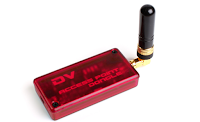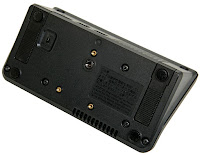GETTING DSTAR TO WORK WITH THE D74 AND A DVAP DONGLE
Being newly licenced, I know pretty much nothing about everything, so DSTAR appears to be quite complicated to me and syntax is everything! One character in the wrong place and you get to hear nothing.
I read (or started to read) lots of articles on setting up Dstar and found them to be of little help to a beginner - mainly because the information is usually related to Icom radios and from what I understand, the Kenwood D74 is really quite different in the way you configure it.
I have spoken to a few Dstar operators and they shy away from helping as soon as you reveal that you're not an Icom user, so my intention here is to help any new D74 owners to get started. I still don't understand the system, but I can hopefully save you hours (maybe days) of struggle, anger and disappointment.
So let's get you on the air and talking! After that, you can work on the rest yourself. I'm assuming that you have registered on the DSTAR Network - if not, do that first. Personally, I went to ICOM's WEBSITE - I recommend that you do the same. It's quick and easy. And in case you're wondering, it doesn't matter which country you're in.
and then come back here.
First of all, don't even bother trying to program from the keypad! You will just waste so much time and get so frustrated.
You need to download the free MCP-D74 Programming Software from Kenwood's website HERE.
You also need to download a Virtual Com Port from this webpage. DO NOT CONNECT YOUR D74 TO THE COMPUTER UNTIL YOU HAVE INSTALLED THIS DRIVER
Once you have downloaded the virtual com port driver and programming software, read the installation instructions on the download pages and follow those instructions to the letter to successfully install the MCP-D74 software.
Okay so you've got the software and driver installed - now you should attach the D74 to your PC with the supplied USB lead. Switch on the radio and read the data from the radio. Select PROGRAM : Read Data From Transceiver (CTRL-R). Then click READ.
Now you need to store some commands and frequencies into Memory Locations. Don't worry, it's easy!
----------------------------------------------------
Bear in mind that if it were possible, you would normally be inputting the frequency of your local Dstar Repeater but you've got a Dongle, so I'm guessing you don't have a repeater close enough to reach reliably.
 My dongle (or HotSpot) is a "DV Access Point" (DVAP) and it has a 70cm transceiver which means that I have to choose a frequency for the dongle to communicate with my D74. Initially I chose 438.625MHz. You choose your own frequency, making sure the frequency doesn't cause any problems with other users/services. The one I choose to operate from now is 438.800MHz. Of course your dongle might be 144, 220 or 433.
My dongle (or HotSpot) is a "DV Access Point" (DVAP) and it has a 70cm transceiver which means that I have to choose a frequency for the dongle to communicate with my D74. Initially I chose 438.625MHz. You choose your own frequency, making sure the frequency doesn't cause any problems with other users/services. The one I choose to operate from now is 438.800MHz. Of course your dongle might be 144, 220 or 433.
----------------------------------------------------
So back to the programming: Starting where you want (I scrolled down to Grp-1, Memory Position 100 for my first command), get ready to insert the frequency of your dongle.
You will note that there are only a few columns visible and we need to open some more up. Click on the Display Items button and tick the boxes shown in the image below.
With all the necessary columns displayed, you can enter the commands into the columns and rows.
Let me just explain (as I understand it in my uneducated way) that when wishing to work Dstar, you have to LINK to a reflector before you can talk on it. When you've finished, you should UNLINK from it. You CQ (talk) on the linked reflector. You can ECHO your transmission (have your transmission played back to you to check how your transmission sounds). You can request INFO from the reflector.
We want to put these commands into separate memories so that it's easy to get to them, simply by rotating the dial. So let's start doing that.
>>>>>>>
In your first chosen Memory Location, insert your dongle's chosen frequency...
Enter NAME as DVAP CQ
Change the Mode to DV.
Enter URCALL as CQCQCQ
Enter RPT1 as DIRECT
Enter RPT2 as DIRECT
>>>>>>>>
That's the first memory complete. Move to the next row down and input the data as shown on the image above, until you've completed all 6 rows.
Send the data to your radio by clicking on the Send Icon.
You now have all the required commands and you have two Reflectors programmed in. Both these reflectors just happen to be American, but that doesn't matter one bit. You will find Hams from all over the world on these two. I particularly like Charlie30 (REF030).
So, what now?
With your dongle active and the blue led flashing, you can go to your radio's memory bank and select the a Reflector from Memory - eg.. Charlie30 (REF030CL). Remember that this memory is programmed to LINK to the Reflector. Once selected, press the PTT button and hold it for a couple of seconds.
You should hear a voice telling you that you are linked to the reflector.
Now go to the memory DVAP CQ and talk!! Just try it by saying something along the lines of....
"<your callsign> requesting a quick radio check"
When you let go of the PTT, there will be a short delay and then (hopefully) someone will come along and respond to your call. Always leave 2 or 3 seconds between overs.
When you've finished talking to your new buddy, say your farewells and then go to the memory that says "DVAP U" to UNLINK from the reflector.
THAT'S IT!! You're a DSTAR user!
Now you can start experimenting by adding more reflectors into memory banks. Just remember that you always start your session by LINKING to a reflector and you always end by UNLINKING. Inbetween you CQ.
Once you start using your radio this way and have fun talking to people across the world, you will soon pick up more tips and tricks and will hopefully learn to connect to Repeaters and Gateways.
I'll say again, I know nothing about everything and I don't claim to understand DSTAR but as I pick up more knowledge, I will add it for the benefit of newbies. If you have snippets to add, then please leave a helpful comment :-)
____________________
UPDATE-1
I forgot to mention that when I first got into one of the Reflectors, there was a LOT of noise in the background as people were speaking to me - it was terrible! The people speaking to me said that my audio was fantastic with full quieting, so I was puzzled.
I explained to the other operators that it sounded like someone had opened up the squelch on an FM signal, allowing a load of floor noise through.
Well guess what? That is exactly what was going on. My D74's sub VFO had been left on the UHF Calling Channel (433.500MHz) and the transmission from the DVAP on 433.625 was opening up the squelch on VFO-B. Operating on 438.800 resolved all issues and is the correct place to use a hotspot anyway.
:-D So the fix was quite simple. Either change the frequency of the DVAP away from the 70cm calling channel or alter the VFO-B frequency. The former is recommended of course.
____________________
UPDATE-2
I received a brief (but very helpful) email from Chris Anderson M6VTX.....
If you are using the Kenwood D74
On a Hot spot you can change
Reflectors with the keypad.
Using DTMF tones.
Here’s how.
Press PTT and then Press # this will unlink you from your current reflector.
To connect to new reflector for example REF001c
Press PTT and then press *1C
A-B-C-D are the top 4 buttons
And for say REF030C *30C
For DCS Reflectors start with D
Say DCS005B=D5B
For XRF start with B
Say XRF012A=B12A
Press PTT and 0 to find out what you are connected to.
You do need to have the CQCQCQ
in the radio as if you were talking on a reflector for this to work.
It makes changing reflector fast and easy.
Ps. Not sure if this works if you are working through a repeater.
73s Chris M6VTX
____________________




























